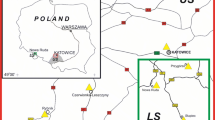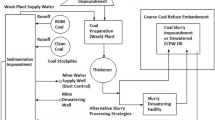Abstract
The environmental benefits of waste desulfurization were evaluated in the Santa Catarina coal field, Brazil. Coal waste from a beneficiation plant was separated into three density fractions, using a two stage process. Characterization of these fractions indicated that the low (D < 2.2 g/cm3) and high (D > 2.7 g/cm3) density fractions were potentially suitable for energy and sulfuric acid production, respectively. The waste fraction of intermediate density (2.2 < D < 2.7 g/cm3) represented 69% of the total mass studied and had a relatively low sulfide content, and it was postulated that it may be suitable for land disposal with minimum risk to the surrounding environment. This hypothesis was tested using laboratory-scale static and kinetic tests, which indicated that although the fraction remained net acid generating, the rate and net amount of metals, salts, and acidity that leached was considerably less than that of the discards before separation. It was concluded that this approach could reduce the amount of waste generated, as well as the associated pollution risk.
抽象

Zusammenfassung
Die Vorteile einer Abfallentschwefelung wurden für das Santa Caterina Kohlevorkommen in Brasilien bewertet. Kohleabfälle einer Aufbereitungsanlage wurden mittels eines zweistufigen Prozesses in drei Dichtefraktionen getrennt. Die Charakterisierung dieser Dichtefraktionen zeigte, das die Fraktionen niedriger (D<2.2 g/cm3) und hoher (D>2.7 g/cm3) Dichte potentiell für die Energie- bzw. Schwefelsäuregewinnung geeignet sind. Die Abfallfraktion mittlerer Dichte (2.2<D<2.7 g/cm3) entsprach 69% der untersuchten Gesamtmasse und besaß einen relativ geringen Sulfidgehalt. Es wurde daher angenommen, dass diese Fraktion mit geringem Risiko für die umgebende Umwelt deponiert werden könnten. Diese Hypothese wurde mit statischen und kinetischen Labortests geprüft. Die Tests ergaben, dass die Fraktion zwar weiterhin eine Netto-Aziditätsproduktion aufwies, aber eine erheblich kleinere als der unfraktionierte Gesamtabfall. Daraus wurde geschlossen, dass mit der Trennung in die Dichtefraktionen sowohl die Abfallmenge als auch das mit dem Abfall verbundene Risiko von Umweltverunreinigungen verringert werden kann.
Resumen
Se evaluaron los beneficios ambientales de la desulfuración de residuos en el campo de carbón Santa Catarina, Brasil. Los residuos de carbón provenientes de una planta de beneficio fueron separados en tres fracciones de distinta densidad, usando un proceso de dos etapas. La caracterización de estas fracciones indicó que las fracciones de baja (D<2,2 g/cm3) y alta (D>2,7 g/cm3) densidad, eran potencialmente generadoras de energía y ácido sulfúrico, respectivamente. La fracción de densidad intermedia (2,2<D<2,7 g/cm3) representaba 69% del total de la masa estudidada y tenía un contenido relativamente bajo de sulfuros por lo que se postuló que era adecuada para su disposición con mínimo riesgo ambiental. Esta hipótesis fue estudiada usando ensayos cinéticos y estáticos a escala de laboratorio los que indicaron que aunque la fracción remanente aún era generadora neta de acidez, la velocidad y la cantidad de metales, sales y acidez que se lixiviaban era considerablemente menor que la que había antes de la separación. Se concluyó que esta aproximación podría reducir la cantidad de residuo generado y del riesgo de polución asociado.




Similar content being viewed by others
References
Acharya C, Kar RN, Sukla LB (2001) Bacterial removal of sulphur from three different coals. Fuel 80:2207–2216
Akcil A, Koldas S (2006) Acid mine drainage (AMD): causes, treatment and case studies. J Clean Prod 14:1139–1145
Amaral Filho JR, Schneider IAH, Brum IAS, Sampaio CH, Miltzarek G, Schneider C (2013) Caracterização de um depósito de rejeitos para o gerenciamento integrado dos resíduos de mineração na região carbonífera de Santa Catarina, Brasil. Rev Esc Minas 66:347–353
APHA (American Public Health Assoc) (2005) Standard methods for the examination of water and wastewater, 21st edit, American Public Health Assoc, Washington DC
ASTM (2002) ASTM D 2492: standard test method for forms of sulfur in coal. ASTM International, West Conshohocken, PA
ASTM (2007a) ASTM D 5744: standard test method for accelerated weathering of solid materials using a modified humidity cell. ASTM International, West Conshohocken, PA
ASTM (2007b) ASTM D 3172: standard test method for proximate analysis of coal and coke. ASTM International, West Conshohocken, PA
ASTM (American Society for Testing and Material) (2009) ASTM D 3176: standard test method for ultimate analysis of coal and coke. ASTM International, West Conshohocken, PA
Barbosa R, Lapa N, Boavida D, Lopes H, Gulyurtlu I, Mendes B (2009) Co-combustion of coal and sewage sludge: chemical and ecotoxicological properties of ashes. J Hazard Mater 170:902–909
Bell FG, Bullock SET, Hälbich TFJ, Lindsay P (2001) Environmental impacts associated with an abandoned mine in the Witbank Coalfield, South Africa. Int J Coal Geol 45:195–216
Benzaazoua M, Bussière B, Demers I, Aubertin M, Fried É, Blier A (2008) Integrated mine tailings management by combining environmental desulphurization and cemented paste backfill: application to mine Doyon, Quebec, Canada. Miner Eng 21:330–340
Bian Z, Inyang HI, Daniels JL, Otto F, Struthers S (2010) Environmental issues from coal mining and their solutions. Min Sci Technol 20:215–223
Bouzahzah H, Benzaazoua M, Bussière B, Plante B (2015) ASTM normalized humidity cell kinetic test: protocol improvements for optimal sulfide tailings reactivity. Mine Water Environ 34:242–257
Fan G, Zhang D, Wang X (2014) Reduction and utilization of coal mine waste rock in China: a case study in Tiefa coalfield. Resour Conserv Recycl 83:24–33
Gomes CJB, Mendes CAB, Costa JFCL (2011) The environmental impact of coal mining: a case study in Brazil’s Sangão watershed. Mine Water Environ 30:159–168
Haibin L, Zhenling L (2010) Recycling utilization patterns of coal mining waste in China. Resour Conserv Recycl 54:1331–1340
Hesketh AH, Broadhurst JL, Bryan CG, Van Hille RP, Harrison STL (2010) Biokinetic test for the characterisation of AMD generation potential of sulfide mineral wastes. Hydrometallurgy 104:459–464
Hilson G (2000) Barriers to implementing cleaner technologies and cleaner production (CP) practices in the mining industry: a case study of the Americas. Miner Eng 13:699–717
Hilson G (2003) Defining “cleaner production” and “pollution prevention” in the mining context. Miner Eng 16:305–321
Johnson DB, Hallberg KB (2005) Acid mine drainage remediation options: a review. Sci Total Environ 338:3–14
Kazadi Mbamba C, Harrison STL, Franzidis J, Broadhurst JL (2012) Mitigating acid rock drainage risks while recovering low-sulfur coal from ultrafine colliery wastes using froth flotation. Miner Eng 29:13–21
Komnitsas K, Paspaliaris I, Zilberchmidt M, Groudev SN (2001) Environmental impacts at coal waste disposal sites-efficiency of desulfurization technologies. Glob Nest Int J 3:109–116
Kontopoulos A (1998) Acid mine drainage control, In: Castro SH, Vergara F, Sanchez MA (eds) Effluent treatment in the mining industry. University of Concepciòn, Concepciòn, pp 57–118
Lapakko KA, Antonson DA (2006) Pyrite oxidation rates from humidity cell testing of greenstone rock. In: Barnhisel RI (ed), Proc, 7th International Conf on Acid Rock Drainage (ICARD), American Soc of Mining and Reclamation (ASMR), Lexington, USA, pp 1007–1025
Lapakko KA, Trujillo E (2015) Pyrite oxidation rates from laboratory tests on waste rock. Proc, 10th ICARD and IMWA Annual Conf, Santiago, Chile
Lengke MF, Davis A, Bucknam C (2010) Improving management of potentially acid generating waste rock. Mine Water Environ 29:29–44
Li XG, Ma BG, Xu L, Hu ZW, Wang XG (2006) Thermogravimetric analysis of the co-combustion of the blends with high ash coal and waste tyres. Thermochim Acta 441:79–83
Li XG, Lv Y, Ma BG, Jian SW, Tan HB (2011) Thermogravimetric investigation on co-combustion characteristics of tobacco residue and high-ash anthracite coal. Bioresour Technol 102:9783–9787
Lundgren DG, Vestal JR, Tabita FR (1972) The microbiology of mine drainage pollution. In: Mitchell R (ed) Water pollution microbiology. Wiley Interscience, New York City, pp 69–88
McLellan BC, Corder GD, Giurco D, Green S (2009) Incorporating sustainable development in the design of mineral processing operations—review and analysis of current approaches. J Clean Prod 17:1414–1425
Muthuraman M, Namioka T, Yoshikawa K (2010) A comparative study on co-combustion performance of municipal solid waste and Indonesian coal with high ash Indian coal: a thermogravimetric analysis. Fuel Process Technol 91:550–558
Reddick JF, Blottnitz H Von, Kothuis B (2008) Cleaner production in the South African coal mining and processing industry: a case study investigation. Int J Coal Prep Util 28:224–236
Runkel M, Sturm P (2009) Pyrite roasting, an alternative to sulphur burning. J South African Inst Min Metall 109:491–496
Sapsford DJ, Bowell RJ, Dey M, Williams KP (2009) Humidity cell tests for the prediction of acid rock drainage. Miner Eng 22:25–36
SIECESC—Sindicato das Indústrias Extratoras de Carvão do Estado de Santa Catarina (2014) http://www.carvaomineral.com.br/conteudo/gm_estatisticas/estatisticas_2014.pdf. Accessed 28 Dec 2015
Silva R, Rubio J (2009) Treatment of acid mine drainage (AMD) from coal mines in south Brazil. Int J Coal Prep Util 29:192–202
Silveira AN, Silva R, Rubio J (2009) Treatment of acid mine drainage (AMD) in south Brazil. Int J Miner Process 93:103–1095
Simate GS, Ndlovu S (2014) Acid mine drainage: challenges and opportunities. J Environ Chem Eng 2:1785–1803
Sobek AA, Schuller WA, Freeman JR (1978) Field and laboratory methods applicable to overburdens and minesoils. EPA-600/2-78-054, Cincinnati
US EPA (Environmental Protection Agency) (1994) Acid mine drainage prediction. EPA 530-R-94-036, Washington DC
Acknowledgements
The authors thank the Brazilian Coal Network, CNPq, FINEP, CCSA, SATC, CTCL, and SIESESC/ABCM for the support provided for this research.
Author information
Authors and Affiliations
Corresponding author
Rights and permissions
About this article
Cite this article
do Amaral Filho, J.R., Weiler, J., Broadhurst, J.L. et al. The Use of Static and Humidity Cell Tests to Assess the Effectiveness of Coal Waste Desulfurization on Acid Rock Drainage Risk. Mine Water Environ 36, 429–435 (2017). https://doi.org/10.1007/s10230-017-0435-7
Received:
Accepted:
Published:
Issue Date:
DOI: https://doi.org/10.1007/s10230-017-0435-7




